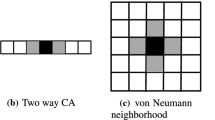Abstract
A self-repair network consists of nodes capable of repairing other nodes where the repair success rate depends on the state (normal or abnormal) of the repairing node. This recursive structure leads to the ”double-edged sword” of repairing, which could cause outbreaks in case the repairing causes adverse effects. The self-repair network can be equated to a probabilistic cellular automaton. Because of the distinction between repair by normal nodes and that by abnormal nodes, transition probabilities as a probabilistic cellular automaton exhibit symmetry.
Access this chapter
Tax calculation will be finalised at checkout
Purchases are for personal use only
Preview
Unable to display preview. Download preview PDF.
Similar content being viewed by others
References
Ishida, Y.: A Critical Phenomenon in a Self-Repair Network by Mutual Copying. In: Khosla, R., Howlett, R.J., Jain, L.C. (eds.) KES 2005. LNCS (LNAI), vol. 3682, pp. 86–92. Springer, Heidelberg (2005)
Rhodes, C.J., Anderson, R.M.: Dynamics in a Lattice Epidemic Model. Phys. Rev. Lett. A 210, 183–188 (1996)
Domany, E., Kinzel, W.: Equivalence of cellular automata to Ising models and directed percolation. Phys. Rev. Lett. 53, 311 (1984)
Nash, J.: The bargaining problem. Econometrica 18, 155–162 (1950)
Koutsoupias, E., Papadimitriou, C.: Worst-case equilibria. In: 16th Annual Symposium on Theoretical Aspects of Computer Science, pp. 404–413 (1999)
Ishida, Y.: Complex Systems Paradigms for Integrating Intelligent Systems. Studies in Computational Intelligence (SCI), vol. 115, pp. 155–181 (2008)
von Neumann, J.J.: Theory of Self-Reproducing Automata. In: Burks, A.W. (ed.). University of Illinois Press, Urbana (1966)
Boole, G.: An investigation of the laws of thought. Macmillan, London (1854)
Spencer-Brown, G.: Laws of Form. Allen & Unwin, London (1969)
Varela, F.: Principles of Biological Autonomy. North Holland, New York (1979)
Author information
Authors and Affiliations
Editor information
Editors and Affiliations
Rights and permissions
Copyright information
© 2010 Springer-Verlag Berlin Heidelberg
About this paper
Cite this paper
Ishida, Y. (2010). A Note on Symmetry in Logic of Self-repair: The Case of a Self-repair Network. In: Setchi, R., Jordanov, I., Howlett, R.J., Jain, L.C. (eds) Knowledge-Based and Intelligent Information and Engineering Systems. KES 2010. Lecture Notes in Computer Science(), vol 6278. Springer, Berlin, Heidelberg. https://doi.org/10.1007/978-3-642-15393-8_73
Download citation
DOI: https://doi.org/10.1007/978-3-642-15393-8_73
Publisher Name: Springer, Berlin, Heidelberg
Print ISBN: 978-3-642-15392-1
Online ISBN: 978-3-642-15393-8
eBook Packages: Computer ScienceComputer Science (R0)




